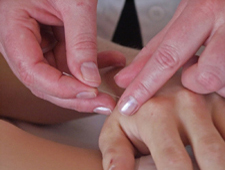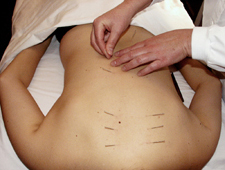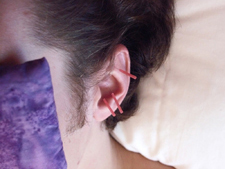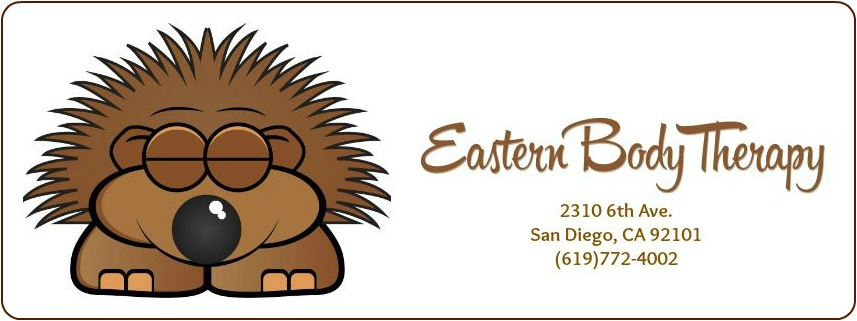What Is Acupuncture | Qi and Traffic | About Those Needles | Why Do Acupuncture | Print This Page
Acupuncture is a system of medicine which has been used in China and other Asian countries for over 2000 years. It involves the insertion of fine needles into specific points on the body in order to influence the flow of qi through pathways called meridians. The needles are sterile, single use, solid metal, and very tiny. Ten of the largest needles used in acupuncture will fit into the opening of a hypodermic needle used to draw blood! 
There are many different styles of acupuncture practice. These include:
- Auricular acupuncture where points used are primarily on the ear
- Hand acupuncture in which the hand is seen as a microsystem for the entire body. Points on the hand are used to influence other areas
- 5 Element acupuncture where most points used are on the forearms and lower legs (including hands and feet)
- Traditional Chinese Medicine in which points are chosen based on their "traditional function"
- Trigger point acupuncture (also called "dry needling") where painful areas of the muscle called trigger points are needled
back to top
From a Chinese Medicine theoretical perspective, acupuncture works by stimulating the flow of qi or vital energy in the meridians. One can look at this like a freeway system in which qi flows like traffic. At some times of day there is more qi in some places than in others. Sometimes, the flow of qi gets stopped (like a traffic accident on the freeway will block traffic). When the flow of qi is stopped or slowed down, there will be too much qi behind the blockage, and too little qi in front of it. Depending on the type of stimulus applied to the needle, acupuncture will either disperse the qi (like the crew that comes to clear the accident scene), or attract qi. Because all illness is considered within the context of organs having too much or too little qi relative to the entire system, this smoothing of the flow of qi serves to relieve imbalances which cause the symptoms we associate with illness.
 From a biomedical perspective, research has been done which shows that stimulation of certain points causes the release of a variety of chemicals in the body including enzymes, neurotransmitters and endorphins. Some points are located at junctions where nerves meet muscles, and needling of these points can have profound effects on the functioning of both the muscle and the nerve involved. Some points even stimulate the production of white blood cells which help to fight infection. It is believed by some that the irritation of having a needle inserted in the skin stimulates a histamine response which then triggers an increase in local circulation, leading to improved cell metabolism and waste removal. French researchers have noted that there is a slight decrease in the electrical potential of the skin at the location of acupuncture points. They have begun to use electrical point locators to ensure that the needle is inserted into the optimal point, and are continuing to examine the implications of this observation. Scientists and doctors continue to do research to better understand the way acupuncture works. back to top From a biomedical perspective, research has been done which shows that stimulation of certain points causes the release of a variety of chemicals in the body including enzymes, neurotransmitters and endorphins. Some points are located at junctions where nerves meet muscles, and needling of these points can have profound effects on the functioning of both the muscle and the nerve involved. Some points even stimulate the production of white blood cells which help to fight infection. It is believed by some that the irritation of having a needle inserted in the skin stimulates a histamine response which then triggers an increase in local circulation, leading to improved cell metabolism and waste removal. French researchers have noted that there is a slight decrease in the electrical potential of the skin at the location of acupuncture points. They have begun to use electrical point locators to ensure that the needle is inserted into the optimal point, and are continuing to examine the implications of this observation. Scientists and doctors continue to do research to better understand the way acupuncture works. back to top
Needles are disposable and come in sterile packages. They are typically used only once, then discarded in a marked sharps container. They are extremely thin, often as small as a cat's whisker. Needles may be inserted with aid of a guide tube (usually plastic) or “freehand”. Insertion is rarely painful, though there may be a sensation of a slight prick like a mosquito bite. At the point when the needle connects with the qi, there is sometimes a sensation of numbness or  heaviness which may be quite intense. It may spread out from the point, and travel along a meridian. Most patients find this sensation odd, but not uncomfortable. There should not be any sharp pain associated with an acupuncture needle. The needles will be left in place for a period of time from 10 minutes to an hour depending on what is being treated, and may be periodically manipulated to maintain the qi sensation. Patients typically report that they experience a deep sense of relaxation and well being while resting with the needles. back to top heaviness which may be quite intense. It may spread out from the point, and travel along a meridian. Most patients find this sensation odd, but not uncomfortable. There should not be any sharp pain associated with an acupuncture needle. The needles will be left in place for a period of time from 10 minutes to an hour depending on what is being treated, and may be periodically manipulated to maintain the qi sensation. Patients typically report that they experience a deep sense of relaxation and well being while resting with the needles. back to top
Acupuncture is a complete system of physical medicine which, when used in conjunction with Chinese herbs, diet therapy, and exercise can treat a wide variety of conditions. In fact, it was the primary form of medicine in most of Asia for thousands of years. Benefits may include pain reduction, improved immune function, reduced muscle spasm, improved muscle and internal organ functioning, faster recovery from illnesses, and increased sense of well being. The benefits will vary from patient to patient, depending on what is being treated and why. In China today, Chinese Medicine is utilized alongside Western Medicine to give patients the benefits of both systems in a complementary way. It is our hope that we can work with you and your doctor to provide YOU with the best of both worlds in medical care. back to top
|

 Yelp About Us
Yelp About Us 

 From a biomedical perspective, research has been done which shows that stimulation of certain points causes the release of a variety of chemicals in the body including enzymes, neurotransmitters and endorphins. Some points are located at junctions where nerves meet muscles, and needling of these points can have profound effects on the functioning of both the muscle and the nerve involved. Some points even stimulate the production of white blood cells which help to fight infection. It is believed by some that the irritation of having a needle inserted in the skin stimulates a histamine response which then triggers an increase in local circulation, leading to improved cell metabolism and waste removal. French researchers have noted that there is a slight decrease in the electrical potential of the skin at the location of acupuncture points. They have begun to use electrical point locators to ensure that the needle is inserted into the optimal point, and are continuing to examine the implications of this observation. Scientists and doctors continue to do research to better understand the way acupuncture works.
From a biomedical perspective, research has been done which shows that stimulation of certain points causes the release of a variety of chemicals in the body including enzymes, neurotransmitters and endorphins. Some points are located at junctions where nerves meet muscles, and needling of these points can have profound effects on the functioning of both the muscle and the nerve involved. Some points even stimulate the production of white blood cells which help to fight infection. It is believed by some that the irritation of having a needle inserted in the skin stimulates a histamine response which then triggers an increase in local circulation, leading to improved cell metabolism and waste removal. French researchers have noted that there is a slight decrease in the electrical potential of the skin at the location of acupuncture points. They have begun to use electrical point locators to ensure that the needle is inserted into the optimal point, and are continuing to examine the implications of this observation. Scientists and doctors continue to do research to better understand the way acupuncture works.  heaviness which may be quite intense. It may spread out from the point, and travel along a meridian. Most patients find this sensation odd, but not uncomfortable. There should not be any sharp pain associated with an acupuncture needle. The needles will be left in place for a period of time from 10 minutes to an hour depending on what is being treated, and may be periodically manipulated to maintain the qi sensation. Patients typically report that they experience a deep sense of relaxation and well being while resting with the needles.
heaviness which may be quite intense. It may spread out from the point, and travel along a meridian. Most patients find this sensation odd, but not uncomfortable. There should not be any sharp pain associated with an acupuncture needle. The needles will be left in place for a period of time from 10 minutes to an hour depending on what is being treated, and may be periodically manipulated to maintain the qi sensation. Patients typically report that they experience a deep sense of relaxation and well being while resting with the needles.